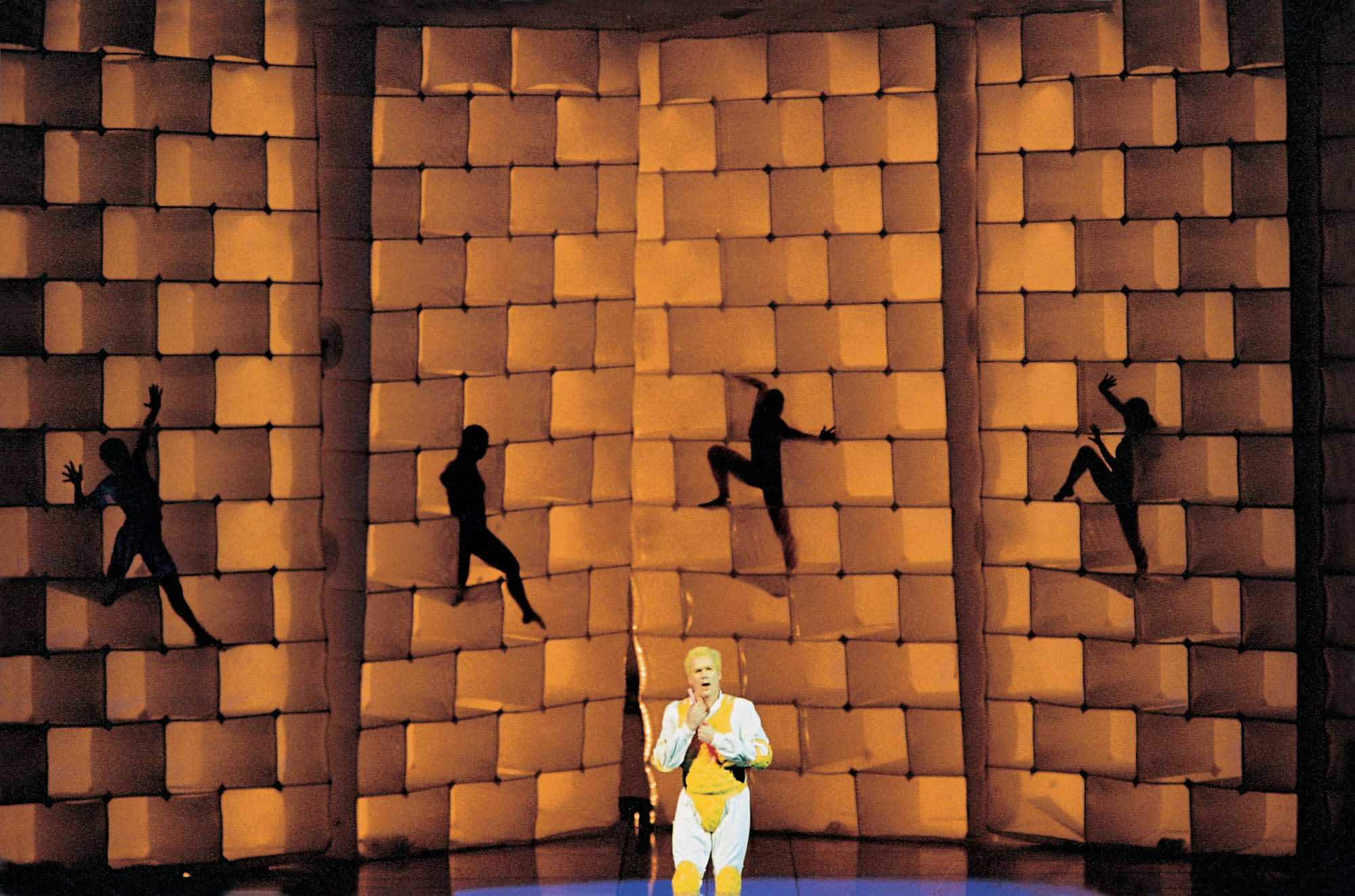Obra
Opera
07.09.2003
Madrid















The Magic Flute is a complex opera, not just because it has been performed innumerable times but also because of its dramatic complexity in terms of the number of scenes and the idiosincracies of each of its characters. This complex nature is further complicated when you consider that in addition to all its popular references, The Magic Flute springs from the imagination, fantasy and madness of Wolfgang Amadeus Mozart, from the subconscious of a genius. We can therefore relate this work to the world of dreams, and it is in this realm that La Fura dels Baus and Jaume Plensa’s staging takes place, in a femtosecond – “a femtosecond is to a second what a second is to thirty-two million years” (Ahmed H. Zewaii) – of dreaming, faster than the blinking of an eye, faster than a spark in the subconscious.
The stage becomes the mind or the palace of knowledge, a pure luminous floor on which the different elements that make up the scene float. The stage is filled with twelve inflatable, ethereal blocks, which can symbolise the units of memory that our minds hold. The staging inevitably reflects the organic nature of the brain, but it also transmits one of its possible symbolisms, that of a space that can be transformed, that is always in a state of flux, in which truth and fiction become mixed and confused. The stage is thus a place of freedom, something that is one of the basic premises of La Fura dels Baus.
There are many possible interpretations for the realm in which The Magic Flute takes place: the proliferation of symbolisms of multiple and uncertain origin; the unassailable nature of the characters in space-time; the fantastic element introduced into the action; the moral lack of definition of the principles that govern the work (since the intended spread of Masonic ideas is not sufficient to justify the attitudes of certain of the characters); this contributes to the ambiguity of the atmosphere on stage.
It is worth mentioning that, as has occurred in previous operatic works by the group, the staging endows the characters with a series of codes, in their costumes or in certain colours, which allows a new reading, different to the classical one.
Música
Wolfgang Amadeus Mozart (1756-1791).
Libreto
Emanuel Schikaneder
Versión escénica
La Fura dels Baus, Jaume Plensa.
Dirección escénica
Àlex Ollé, Carlos Padrissa (La Fura dels Baus).
Escenografía y vestuario
Jaume Plensa
Dirección musical
Marc Minkowski
Textos
Rafael Argullol
Creación y realización vídeo
Franc Aleu
Diseño de iluminación
Albert Faura
Ayudante de dirección
Valentina Carrasco
Asistente dramaturgia
Joachim Rathke
Dirección Coro
Walter Zeh
Reparto
Sarastro: Kwangchul Youn.
Tamino: Matthias Klink.
Orador: Olaf Bar.
Reina de la Noche: Erika Miklosa.
Pamina: Genia Kühmeier.
Primera dama: Dorothee Jansen.
Segunda dama: Marie-Belle Sandis.
Tercera dama: Marijana Mijanovic.
Papagena: Anne Cambier.
Papageno: Christian Gerhaher.
Monostatos: Burkhard Ulrich,
Markus Brutscher.
Tres niños: Sebastian Kausch, Raymond Leist, Paul Komusidi.
Hombre armado 1: Burkhard Fritz.
Hombre armado 2: Bernd Hofmann.
Sacerdote 1: Martin Busen.
Sacerdote 2: Thomas Ebenstein.
Voz en off: Dorte Lyssewski.
Vieja Papagena: Kazimiera Czakanski.
Les Musiciens du Louvre-Grenoble
Chor der Ruhrtriennale.
Bailarines
Lenka Bartunkova, Joris Camelin, Pavlina Cerna, Chihn-Lin Chan, Li-Li Chao, Andreas Ebbert-Scholl, Daniel Fetecva-Soto, Shirley Geacoman, Senem Gokce Gaeltekin, Alexeider Abad González, Manon Greiner, Giorgos Kamposoris, Chih-Ying Ku, Anja Kursawe, Sofian Labbani, Jorge Leandro, Carlos Martínez Paz, Carolina Varassi Pega, Kathryn Ressle, Mata Sakka, Edgar Sandovaz-Diaz, Jürgen Sieger, Simon Solberg, Lisa Stockinger, Simon Viersma, Jan Viethen, Roberto Zúñiga.
Asistente musical
Jérémie Rhorer, Mirella Giardelli.
Dirección técnica
Alberto Pastor
Realización escenográfica
Quim Guixá, Masters S.A, Scenotechnics.
Realización vestuario
Catou Verdier
Asistente vestuario
Tina Carstens
Regiduría
Angela Beuerle, Tine Buyse, Santiago Castillo, Isabel Franco, Carten Kirchmeier,
Katrin Reichardt.
Producción ejecutiva
Marta Pérez Porro
Estreno
7/9/03, en el Jahrunderthalle, Bochum.
Representaciones
10
Una coproducción de la Ruhrtriennale, bajo la dirección de Gerard Mortier; la Opéra National de París y el Teatro Real de Madrid.
Conceived and developed by La Fura dels Baus and Jaume Plensa, this staging of Mozart’s classic—one of the world’s best-known operas—explores the piece’s dream aspects in an attempt to employ all types of art.